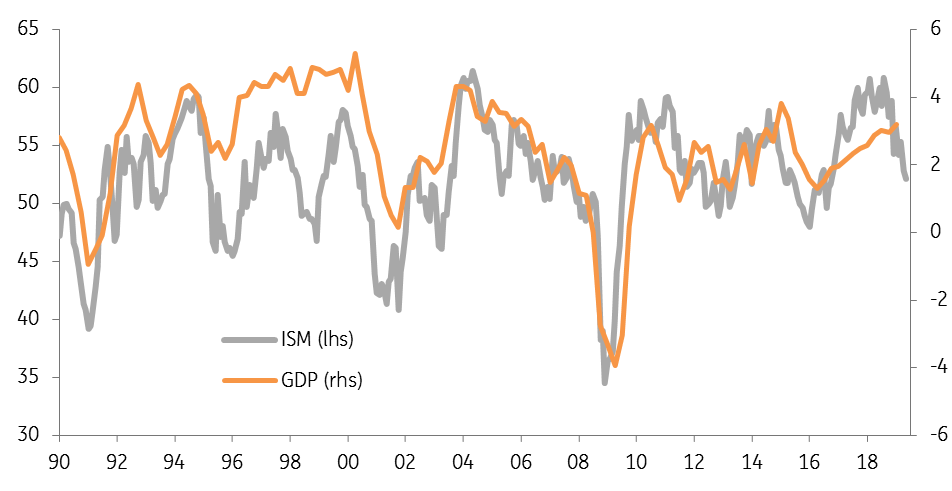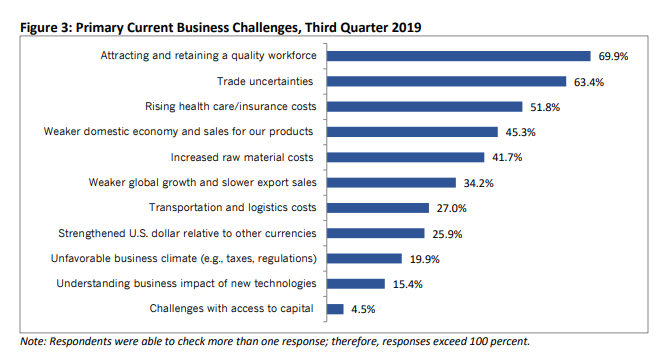There's a commonly held belief that manufacturing leads the rest of the economy, so declining indicators in manufacturing can produce anxiety for other sectors such as distribution and retailing.
Some argue there's a decoupling trend as we shift to a more service-intensive economy that renders actually "making stuff" a statistical slideshow. However, the data does not necessarily support this theory. Manufacturing is still a key component of the overall economy. Why it's often considered a "leading indicator" seems to stem in large part from the fact that monthly manufacturing data comes out well ahead of the quarterly US GDP release — which is considered the reference standard for how the economy is performing. This makes manufacturing indices an early read on the overall economy.
However, that is not the same thing as leading the rest of the economy.
As it turns out, manufacturing can grow at a faster or slower rate than US GDP for years at a time, and recent trends suggest this is still the case. Moreover, US manufacturing activity turns out to be a highly “coincident indicator” to GDP, and a volatile one at that.

ISM Manufacturing Index vs U.S. Gross Domestic Product
So in the long run, manufacturing mirrors the economy rather than leads it. Nevertheless, businesses throughout the delivery chain pay very close attention to the manufacturing sector. And what they seem to pay the greatest attention to is not how manufacturers are "doing", but rather what they are “saying.”
What manufacturers say is often a reflection of what they expect to see in the quarters ahead, what they will be paying closest attention, and where they will be investing. And for the most part, nothing gets distributed or sold until it’s made. This means the rest of the economy can expect to realize these same effects in their businesses and may wish to closely follow suit with their manufacturing brethren, if not be more proactive.
In a survey conducted in the latest quarter (Q3 2019) by the National Association of Manufacturers, what was top of mind to most manufacturing executives were business concerns and uncertainties around workforce, trade, weakening demand, and rising costs.

These concerns translate directly to having to do more with less - and finding ways to preserve if not improve margins to maintain profitability. They also point to the need to find innovative ways to grow their existing business should new business be difficult to acquire.
In an uncertain environment, the low-hanging fruit always begins with cost-cutting and maintaining or growing business with existing customers. Some of the best ways to do this are to find ways to improve gross margin through more effective pricing, as well as reducing customer churn and finding incremental growth opportunities in their customer portfolios. And coincidentally, the latter can also be executed effectively through better pricing outcomes.
Manufacturers, distributors, and retailers who will be best-positioned in uncertain times are those who have the best tools and processes in place to ensure they are getting the most from every sale and every customer, i.e. the right price for the right customer at the right time and in the right way.
However, the same holds true when there is “not a cloud on the horizon.” Proactively addressing your pricing approach when outlooks are positive in the manufacturing sector and beyond is just smart business. When growth seems certain, effective pricing captures greater upside potential and provides margin expansion opportunities even as more product leaves the factory.
Those who are able to outperform through certainty, as well as uncertainty, will bring effective product pricing to the forefront of their strategy. The winners will establish the optimal price on each transaction in order to grow their business more than the competition while preserving or expanding margins.
So in a manner of speaking, pricing is the leading action businesses can and should take to make sure they are prepared for what lies ahead, regardless of which direction the market goes.
About the Author
Kyle Nations is Sales Director at Zilliant helping global B2B companies realize improved financial performance using advanced technology for optimal pricing & sales effectiveness.



